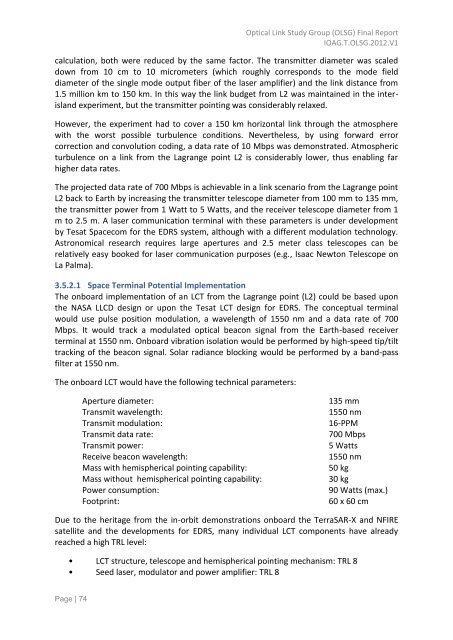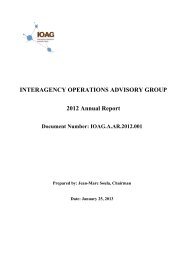OLSG Report_Final_06_05_12 - Interagency Operations Advisory ...
OLSG Report_Final_06_05_12 - Interagency Operations Advisory ...
OLSG Report_Final_06_05_12 - Interagency Operations Advisory ...
Create successful ePaper yourself
Turn your PDF publications into a flip-book with our unique Google optimized e-Paper software.
Optical Link Study Group (<strong>OLSG</strong>) <strong>Final</strong> <strong>Report</strong><br />
IOAG.T.<strong>OLSG</strong>.20<strong>12</strong>.V1<br />
calculation, both were reduced by the same factor. The transmitter diameter was scaled<br />
down from 10 cm to 10 micrometers (which roughly corresponds to the mode field<br />
diameter of the single mode output fiber of the laser amplifier) and the link distance from<br />
1.5 million km to 150 km. In this way the link budget from L2 was maintained in the interisland<br />
experiment, but the transmitter pointing was considerably relaxed.<br />
However, the experiment had to cover a 150 km horizontal link through the atmosphere<br />
with the worst possible turbulence conditions. Nevertheless, by using forward error<br />
correction and convolution coding, a data rate of 10 Mbps was demonstrated. Atmospheric<br />
turbulence on a link from the Lagrange point L2 is considerably lower, thus enabling far<br />
higher data rates.<br />
The projected data rate of 700 Mbps is achievable in a link scenario from the Lagrange point<br />
L2 back to Earth by increasing the transmitter telescope diameter from 100 mm to 135 mm,<br />
the transmitter power from 1 Watt to 5 Watts, and the receiver telescope diameter from 1<br />
m to 2.5 m. A laser communication terminal with these parameters is under development<br />
by Tesat Spacecom for the EDRS system, although with a different modulation technology.<br />
Astronomical research requires large apertures and 2.5 meter class telescopes can be<br />
relatively easy booked for laser communication purposes (e.g., Isaac Newton Telescope on<br />
La Palma).<br />
3.5.2.1 Space Terminal Potential Implementation<br />
The onboard implementation of an LCT from the Lagrange point (L2) could be based upon<br />
the NASA LLCD design or upon the Tesat LCT design for EDRS. The conceptual terminal<br />
would use pulse position modulation, a wavelength of 1550 nm and a data rate of 700<br />
Mbps. It would track a modulated optical beacon signal from the Earth-based receiver<br />
terminal at 1550 nm. Onboard vibration isolation would be performed by high-speed tip/tilt<br />
tracking of the beacon signal. Solar radiance blocking would be performed by a band-pass<br />
filter at 1550 nm.<br />
The onboard LCT would have the following technical parameters:<br />
Aperture diameter:<br />
Transmit wavelength:<br />
Transmit modulation:<br />
Transmit data rate:<br />
Transmit power:<br />
Receive beacon wavelength:<br />
Mass with hemispherical pointing capability:<br />
Mass without hemispherical pointing capability:<br />
Power consumption:<br />
Footprint:<br />
135 mm<br />
1550 nm<br />
16-PPM<br />
700 Mbps<br />
5 Watts<br />
1550 nm<br />
50 kg<br />
30 kg<br />
90 Watts (max.)<br />
60 x 60 cm<br />
Due to the heritage from the in-orbit demonstrations onboard the TerraSAR-X and NFIRE<br />
satellite and the developments for EDRS, many individual LCT components have already<br />
reached a high TRL level:<br />
• LCT structure, telescope and hemispherical pointing mechanism: TRL 8<br />
• Seed laser, modulator and power amplifier: TRL 8<br />
Page | 74



